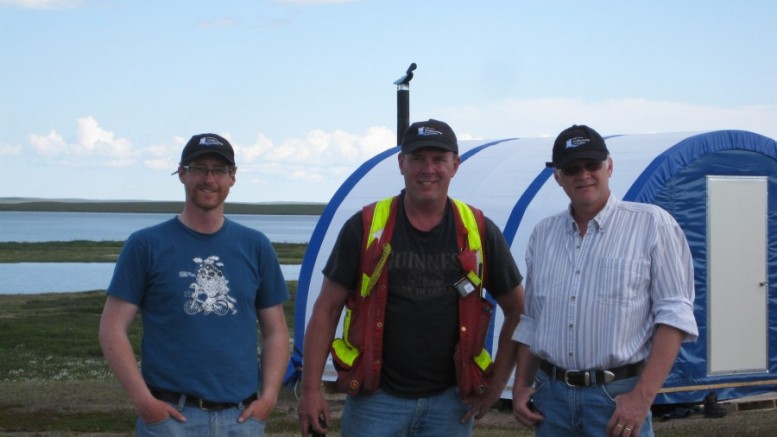Kivalliq Energy (KIV-V) is cashed-up and moving forward with an ambitious exploration program on its 1,000-sq.-km Angilak property in Nunavut, just as the Nunavut government has formalized its uranium policy.
The company completed an $11.6-million financing at 50¢ per flow-through share at the end of May, which follows a $9.5-million financing at 45¢ in February. Together, this will cover the $20 million in exploration planned this year.
Kivalliq CEO Jim Paterson excitedly describes the 2012 program as “one of the largest exploration programs on the planet for a uranium junior” in a phone interview.
The company hopes to expand the existing resource centred around its Lac Cinquante deposit, and test some of the many other targets it has identified so far on the property.
A January resource update on the Lac Cinquante deposit established 1.8 million inferred tonnes grading 0.69% uranium oxide, plus 16.3 grams silver per tonne, 0.16% molybdenum and 0.25% copper for 27.1 million contained lb. uranium oxide plus by-products using a 0.2% cut-off. The update represented a 92% increase in the resource and led to the company’s share price briefly spiking from 40¢ to 64¢.
Kivalliq secured the Lac Cinquante deposit as part of a deal with Nunavut Tunngavik Inc. (NTI), the government entity tasked with managing land from the Nunavut Land Claims Agreement. The deal came after NTI outlined clear policies on uranium mining and exploration in 2007, which opened the door for expanded exploration and allowed the government to vend out its Lac Cinquante project for development.
“We’re certainly happy to have, effectively, the blessing of NTI in terms of looking for uranium in Nunavut,” Paterson says of the deal.
The Nunavut government passed clear guidelines on uranium development in the territory in early June. The formalized policy does little to change the situation on the ground, but as Eric Prosh, director of Mineral and Petroleum Resources for the government of Nunavut, explains by phone, the passage of the policy gives better certainty going forward.
“It does give a greater degree of confidence, particularly to the juniors, and to their investors, that there is a degree of stability that they can look forward to over the years, because it’s a long-term process,” Prosh says.
The new policy states that the uranium must be used for peaceful purposes; locals must be the major beneficiaries; health, safety and environmental standards have to be stringent; and that uranium exploration and mining must have the support of the people of Nunavut, especially communities close to uranium development.
There is still opposition to uranium exploration and development in the territory — most prominently led by a group known as Makita — but Prosh says any concerns would be best addressed on a case-by-case basis within the regulatory process.
For Kivalliq, the new policy further solidifies its working relationship with the Nunavut government, which started in 2007. At the time the deal was made with Kaminak Gold (KAM-V), but the company focused on its Yukon holdings and spun out Kivalliq in 2008 to develop the uranium holdings. Rob Carpenter, co-founder of Kaminak, is still a technical advisor for Kivalliq, and Paterson serves on Kaminak’s board.
For 2012 the company’s exploration program includes 26,000 metres of core drilling and 9,000 metres of reverse-circulation drilling, plus further ground geophysics and prospecting. In late June the company said it had completed 14,700 metres of drilling, plus 445 line km of ground geophysics as it works to shore up some of its recent discoveries near the established resource — including Blaze, Pulse and Spark — and test some of its more far-flung targets to show the property has district potential.
“For us to prove the thesis that these other conductive targets — running parallel and within a few km of Lac Cinquant — actually run, and that Lac Cinquant is not a unique deposit, is actually pretty powerful,” Paterson says. “Because that sets the stage for us to show the growth potential and get us to a level where we’re showing this is a new uranium district, rather than a solitary deposit.”
As to the Lac Cinquant resource increase, Paterson says he’s pleased the company could incorporate the Western and Eastern extensions of the deposit that it discovered last year, and is encouraged that the deposits fit with his team’s geological expectations for the property.
“We knew they were geophysical conductors. We knew they were legitimate targets. But we didn’t know they were mineralized until we drilled them last year,” Paterson says.
Kivalliq funded its sizeable exploration program this year in part because it has some well-regarded backers, including Ross Beaty’s Lumina Capital. The fund has owned 18.2% of Kivalliq’s 149.2 million outstanding shares since adding 4 million shares to its total in the February financing.
“Lumina provides great creditably because evidently they know what they’re doing, and they provide some comfort to investors that don’t have a technical background,” Paterson says.
Other big groups bringing some indirect credibility to Kivalliq’s story are Areva and Cameco (CCO-T, CCJ-N), with both investing millions to advance their own uranium projects in Nunavut. Areva is working to permit its Kiggavik project, which if successful, will add legitimacy and infrastructure to Nunavut’s mining industry.
But Paterson’s also looking to Kivalliq to highlight Nunavut’s potential as a uranium destination.
“If Kivalliq can prove to the world that this is a new uranium district, then I think it’s going to be a fabulous jurisdiction going forward for other uranium companies to be active as well,” he says.


Be the first to comment on "Kivalliq eyeing new uranium district in Nunavut"